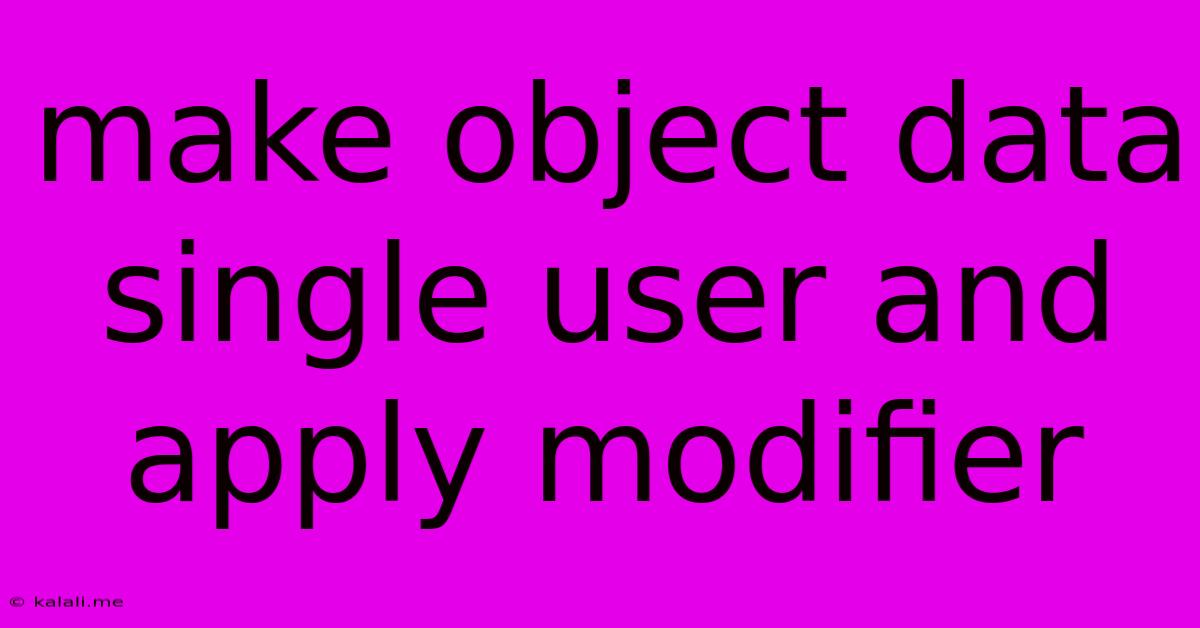Make Object Data Single User And Apply Modifier
Kalali
May 23, 2025 · 4 min read

Table of Contents
Making Object Data Single-User and Applying Modifiers: A Comprehensive Guide
This article delves into the crucial aspects of data management, focusing on how to enforce single-user access to object data and effectively utilize modifiers to control data manipulation. Understanding these concepts is paramount for maintaining data integrity, preventing conflicts, and ensuring the smooth operation of any application relying on shared resources. We'll explore practical strategies and best practices to achieve this, applicable across various programming paradigms and database systems.
Understanding the Need for Single-User Access
In multi-user environments, where multiple users or processes might access and modify the same data simultaneously, the risk of data corruption or inconsistencies is significantly high. Imagine two users updating the same record – the last one to save their changes might overwrite the other's modifications, leading to data loss or inaccurate information. Therefore, implementing single-user access mechanisms is vital for maintaining data integrity and ensuring reliable operations. This is especially crucial for sensitive data like financial records, medical information, or user accounts.
Strategies for Implementing Single-User Access
Several strategies can be employed to enforce single-user access to object data. These strategies vary in complexity and suitability depending on the specific application and environment. Let's explore some key methods:
-
File Locking: This is a common approach where a lock is placed on the data file before it's accessed. Only the user who successfully acquires the lock can modify the data. Once finished, the lock is released, allowing other users to access the file. This approach is relatively simple but can be prone to deadlocks if not implemented carefully.
-
Database Transactions: Database management systems (DBMS) provide transaction mechanisms that guarantee atomicity, consistency, isolation, and durability (ACID properties). Transactions ensure that data modifications are treated as a single, indivisible unit. If any part of the transaction fails, the entire transaction is rolled back, preventing partial updates and maintaining data integrity. This is a robust approach for managing concurrent access to data within a database.
-
Optimistic Locking: This approach assumes that conflicts are rare. It doesn't lock the data until the changes are saved. Before saving, the system checks if the data has been modified by another user since it was last retrieved. If a conflict is detected, the update is rejected, and the user is notified. This method is less prone to deadlocks than pessimistic locking but may require more complex error handling.
-
Pessimistic Locking: In contrast to optimistic locking, pessimistic locking assumes that conflicts are common. It locks the data immediately upon retrieval, preventing other users from accessing or modifying it until the lock is released. This is a strong approach but can significantly impact performance and potentially lead to deadlocks if not managed carefully.
Leveraging Modifiers for Controlled Data Manipulation
Modifiers further enhance the control over data access and manipulation. They provide mechanisms to restrict or limit the types of operations that can be performed on the data. Examples include:
-
Read-only access: This modifier prevents users from modifying the data, ensuring data integrity in situations where only read access is required.
-
Write access with validation: This modifier allows modification but incorporates validation rules to prevent invalid or inconsistent data from being entered. This might involve data type checks, range constraints, or more complex business rules.
-
Version control: This maintains different versions of the object data, allowing rollback to previous states if necessary. This is highly beneficial for managing changes and facilitating recovery from errors.
Best Practices and Considerations
-
Choose the right strategy: The optimal strategy for single-user access depends on the specific application requirements, performance constraints, and concurrency levels. Careful consideration of these factors is crucial for selecting the most effective approach.
-
Error handling: Implement robust error handling mechanisms to gracefully handle situations such as lock conflicts or data validation failures. Providing clear and informative error messages to the user is essential for a positive user experience.
-
Performance optimization: Some methods, like pessimistic locking, can significantly impact performance. Optimize the implementation to minimize performance overhead and ensure the application remains responsive.
-
Security considerations: Securely manage access control to object data to prevent unauthorized access or modification. This may involve employing authentication and authorization mechanisms.
By understanding these concepts and implementing appropriate strategies and best practices, developers can effectively ensure single-user access to object data, preventing conflicts and maintaining data integrity, ultimately leading to more robust and reliable applications.
Latest Posts
Latest Posts
-
When Performing A Self Rescue When Should You Swim To Shore
Jul 15, 2025
-
How Many Decaliters Are In A Liter
Jul 15, 2025
-
What Note Sits In The Middle Of The Grand Staff
Jul 15, 2025
-
Did Lynette Shave Her Head In Real Life
Jul 15, 2025
-
How Many Yards Are In 45 Feet
Jul 15, 2025
Related Post
Thank you for visiting our website which covers about Make Object Data Single User And Apply Modifier . We hope the information provided has been useful to you. Feel free to contact us if you have any questions or need further assistance. See you next time and don't miss to bookmark.